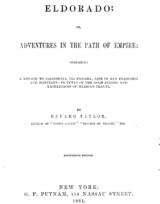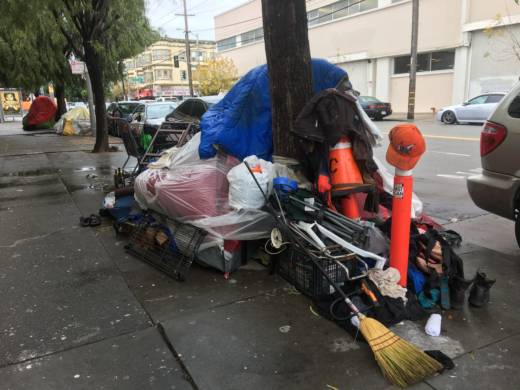From "Eldorado; or Adventures in the Path of Empire," by Bayard Taylor. He came to San Francisco during the early days of the Gold Rush to document the scene in California for the New York Tribune. Here's his observation of conditions on the city streets as the rainy season set in.
T
owards the close of my stay, the city was as dismal a place as could well be imagined. The glimpse of bright, warm, serene weather passed away, leaving in its stead a raw, cheerless southeast storm. The wind now and then blew a heavy gale, and the cold, steady fall of rain was varied by claps of thunder and sudden blasts of hail. The mud in the streets became little short of fathomless, and it was with difficulty that the mules could drag their empty wagons through. ...
"The plank side-walks in the lower part of the city ran along the brink of pools and quicksands, which the Street Inspector and his men vainly endeavored to fill by hauling cart loads of chaparral and throwing sand on the top; in a day or two, the gulf was as deep as ever. The side-walks, which were made at the cost of $5 per foot, bridged over the worst spots, but I was frequently obliged to go the whole length of a block in order to get on the other side. One could not walk any distance, without getting at least ankle-deep, and although the thermometer rarely sank below 50 it was impossible to stand still for even a short time without a death like chill taking hold of the feet. ...

"The severe weather occasioned a great deal of sickness, especially among those who led an exposed life. The city overflowed with people, and notwithstanding buildings were continually growing up like mushrooms, over night, hundreds who arrived were obliged to lodge in tents, with which the summits of the hills were covered. Fever and ague and dysentery were the prevailing complaints, the great prevalence of which was owing undoubtedly to exposure and an irregular habit of life.
"An association was formed to relieve those in actual want, many of the wealthiest and most influential citizens taking an honorable part in the matter. Many instances of lamentable destitution were by this means brought to light. Nearly all the hospitals of the place were soon filled, and numbers went to the Sandwich [Hawaiian] Islands to recruit [recover]. The City Hospital, a large, well-ventilated and regulated establishment, contained about 50 patients.
